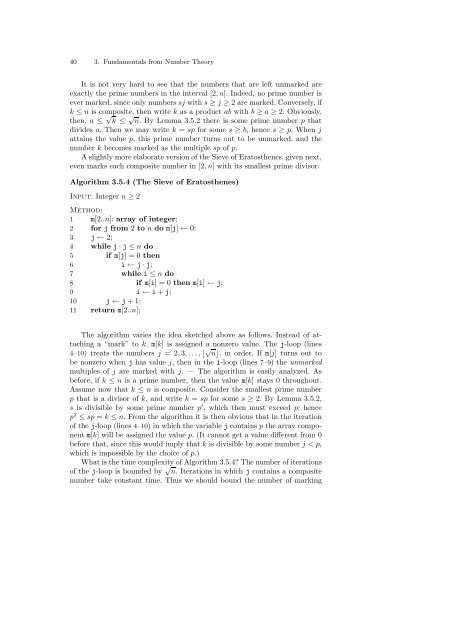Dietzfelbinger M. Primality testing in polynomial time ... - tiera.ru
Dietzfelbinger M. Primality testing in polynomial time ... - tiera.ru
Dietzfelbinger M. Primality testing in polynomial time ... - tiera.ru
You also want an ePaper? Increase the reach of your titles
YUMPU automatically turns print PDFs into web optimized ePapers that Google loves.
40 3. Fundamentals from Number Theory<br />
It is not very hard to see that the numbers that are left unmarked are<br />
exactly the prime numbers <strong>in</strong> the <strong>in</strong>terval [2,n]. Indeed, no prime number is<br />
ever marked, s<strong>in</strong>ce only numbers sj with s ≥ j ≥ 2 are marked. Conversely, if<br />
k ≤ n is composite, then write k as a product ab with b ≥ a ≥ 2. Obviously,<br />
then, a ≤ √ k ≤ √ n. By Lemma 3.5.2 there is some prime number p that<br />
divides a. Thenwemaywritek = sp for some s ≥ b, hence s ≥ p. Whenj<br />
atta<strong>in</strong>s the value p, this prime number turns out to be unmarked, and the<br />
number k becomes marked as the multiple sp of p.<br />
A slightly more elaborate version of the Sieve of Eratosthenes, given next,<br />
even marks each composite number <strong>in</strong> [2,n] with its smallest prime divisor.<br />
Algorithm 3.5.4 (The Sieve of Eratosthenes)<br />
Input: Integer n ≥ 2<br />
Method:<br />
1 m[2..n]: array of <strong>in</strong>teger;<br />
2 for j from 2 to n do m[j] ← 0;<br />
3 j ← 2;<br />
4 while j · j ≤ n do<br />
5 if m[j] =0then<br />
6 i ← j · j;<br />
7 while i ≤ n do<br />
8 if m[i] =0then m[i] ← j;<br />
9 i ← i + j;<br />
10 j ← j +1;<br />
11 return m[2..n];<br />
The algorithm varies the idea sketched above as follows. Instead of attach<strong>in</strong>g<br />
a “mark” to k, m[k] is assigned a nonzero value. The j-loop (l<strong>in</strong>es<br />
4–10) treatsthenumbersj =2, 3,...,⌊ √ n⌋, <strong>in</strong>order.Ifm[j] turns out to<br />
be nonzero when j has value j, then<strong>in</strong>thei-loop (l<strong>in</strong>es 7–9) theunmarked<br />
multiples of j are marked with j. — The algorithm is easily analyzed. As<br />
before, if k ≤ n is a prime number, then the value m[k] stays 0 throughout.<br />
Assume now that k ≤ n is composite. Consider the smallest prime number<br />
p that is a divisor of k, andwritek = sp for some s ≥ 2. By Lemma 3.5.2,<br />
s is divisible by some prime number p ′ , which then must exceed p; hence<br />
p 2 ≤ sp = k ≤ n. From the algorithm it is then obvious that <strong>in</strong> the iteration<br />
of the j-loop (l<strong>in</strong>es 4–10) <strong>in</strong> which the variable j conta<strong>in</strong>s p the array component<br />
m[k] will be assigned the value p. (It cannot get a value different from 0<br />
before that, s<strong>in</strong>ce this would imply that k is divisible by some number j












